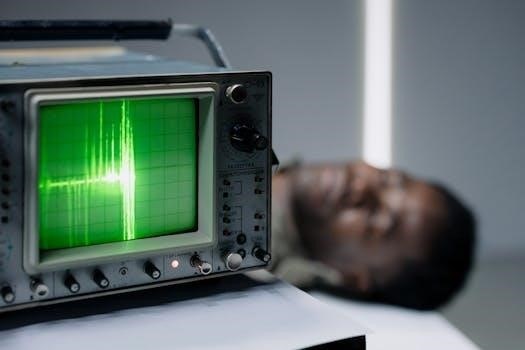General Chemistry Lab Manual⁚ An Overview
This manual serves as a practical guide for general chemistry laboratory courses․ It emphasizes hands-on learning, covering fundamental principles․ It also includes safety guidelines, data analysis, and experimental techniques for practical application․
General chemistry lab manuals are essential resources for students embarking on their journey into the world of chemistry․ These manuals provide a structured approach to learning, guiding students through experiments designed to reinforce theoretical concepts learned in lectures․ They serve as a bridge between textbook knowledge and practical application, allowing students to engage directly with chemical principles through hands-on activities․ Lab manuals typically include detailed procedures, safety guidelines, and space for data recording and analysis․ The goal is to foster a deeper understanding of chemistry by providing real-world experience․ They facilitate the development of critical thinking skills․ These skills are necessary for the scientific method through experimentation and observation․ Furthermore, they emphasize the importance of meticulousness and accurate data collection․ They are indispensable tools for any student taking a general chemistry course․ They are integral to a comprehensive understanding of chemical concepts․
Purpose and Goals of the Lab Manual
The primary purpose of a general chemistry lab manual is to provide students with a practical, hands-on approach to learning chemistry․ Its main goal is to reinforce theoretical concepts through experimentation, thus fostering a deeper understanding of chemical principles․ These manuals aim to develop essential laboratory skills, including proper techniques for handling equipment, collecting data, and analyzing results․ Additionally, they emphasize the importance of laboratory safety and proper procedures for chemical disposal․ Through structured experiments, students learn to apply the scientific method and develop critical thinking skills․ These skills are necessary for scientific inquiry․ The lab manual also serves as a guide for accurate data documentation and analysis․ It encourages a meticulous approach to experimental work, thereby enhancing the students’ overall learning experience․ Ultimately, the purpose is to translate theoretical knowledge into practical skills․ This prepares students for further studies in chemistry and related fields․

Key Components of a General Chemistry Lab Manual
Essential components include safety guidelines, experimental procedures, and data documentation․ The manual also contains techniques, analysis methods, and equipment handling protocols․ These elements are crucial for student success․
Laboratory Safety Guidelines and Procedures
Laboratory safety is paramount, requiring strict adherence to guidelines․ These procedures ensure a secure environment for all students and instructors․ The manual outlines essential safety protocols, including proper attire, such as wearing appropriate personal protective equipment like goggles and lab coats․ It also details the handling of chemicals, emphasizing the correct methods for storage, usage, and disposal to prevent accidents․ Students must understand the importance of using fume hoods when working with volatile or hazardous substances․ Additionally, the manual covers emergency procedures, including the location of safety equipment like fire extinguishers and eyewash stations, and outlines protocols for reporting accidents and spills․ Proper training is crucial for students to be aware of potential risks and react effectively to unforeseen situations in the laboratory․ Regular safety quizzes and demonstrations are also frequently employed to reinforce these critical safety practices․
Essential Laboratory Techniques
Mastering essential laboratory techniques is crucial for successful experimentation․ The manual details fundamental procedures, such as precise measurements using various instruments, including balances and burettes․ Proper techniques for handling glassware, like pipetting and titration, are explained, ensuring accurate results․ It emphasizes the importance of careful observation and recording of data․ Students learn how to conduct filtrations, distillations, and recrystallizations․ The manual also covers the methods for heating substances safely using various equipment, from hot plates to Bunsen burners․ The use of specific tools for mixing solutions, like magnetic stirrers, is also included․ It stresses meticulous technique, aiming to reduce experimental error and improve the validity of results․ Proper technique also includes proper cleaning methods for all equipment used after each lab session to ensure the next experiment is not compromised by cross-contamination․
Data Documentation and Analysis
Accurate data documentation and analysis are critical to the scientific process, and a general chemistry lab manual provides detailed guidance on these aspects․ The manual emphasizes the importance of recording all observations, measurements, and procedures in a laboratory notebook․ It outlines the proper format for data tables, ensuring all relevant information is present and clearly labeled․ It includes instruction on how to graph data effectively to identify trends and relationships․ The manual also teaches students how to perform calculations accurately, applying relevant formulas and units․ Students learn to determine uncertainties in measurements and calculate experimental errors․ The importance of documenting potential sources of error is stressed․ Statistical analysis techniques, such as calculating mean and standard deviation, are covered to aid in evaluating data reliability․ The manual further instructs students on how to interpret results and draw valid conclusions based on their experimental data․

Content and Structure of a Typical Manual
A typical manual includes experiments demonstrating core concepts, focusing on properties of substances․ It also incorporates qualitative analysis and provides detailed procedures, aiding hands-on learning for students․
Experiments Covering Fundamental Principles
General chemistry lab manuals often feature experiments designed to illustrate core concepts․ These experiments typically cover areas such as atomic structure, chemical bonding, and stoichiometry․ Students engage in hands-on activities, solidifying their understanding of these fundamental principles․ Gas laws and thermodynamics are also explored through practical experiments․ The experiments are structured to reinforce theoretical knowledge with empirical observation․ These experiments often include detailed procedures, data collection, and analysis sections․ They ensure students gain practical experience in applying chemical principles․ The experiments are crucial for demonstrating how theoretical concepts translate into tangible, observable phenomena․ They enable students to make connections between the abstract and the concrete aspects of chemistry․ The experimental design often integrates environmental awareness, promoting responsible laboratory practices․ The aim is to cultivate a deep understanding of basic chemical concepts, using experimentation as the primary teaching tool․
Focus on Chemical and Physical Properties
A significant portion of general chemistry lab manuals is dedicated to experiments focused on chemical and physical properties of substances․ These experiments involve techniques to identify and analyze different materials, emphasizing observational skills․ Students explore physical properties such as solubility, density, and melting points․ They also investigate chemical properties like reactivity and oxidation-reduction reactions․ The experiments guide students through the process of distinguishing between physical and chemical changes․ They are designed to teach students how different factors affect these properties․ This section often involves qualitative analysis, where students identify substances based on their characteristics․ Furthermore, the experiments promote understanding of how these properties relate to the structure and behavior of matter․ These activities are essential for students to grasp the practical implications of chemical theory․ Practical work is central to understanding how these properties are determined and utilized in chemistry․
Qualitative Analysis Experiments
Qualitative analysis experiments form a crucial part of general chemistry lab manuals, focusing on identifying substances through observation and chemical reactions․ These experiments involve the systematic analysis of unknown samples, relying on visual cues, color changes, and other observable phenomena․ Students learn to perform various tests to identify specific ions and compounds, using techniques such as precipitation, complexation, and redox reactions․ These experiments emphasize deductive reasoning and meticulous observation․ The procedures train students to record data precisely, interpret results accurately, and draw logical conclusions․ Qualitative analysis is vital for comprehending the practical applications of chemical properties․ The section often includes procedures for identifying both cations and anions using specific reagents and conditions․ This approach not only reinforces theoretical knowledge but also develops essential lab skills․ Therefore, these experiments help students understand the fundamental principles behind chemical analysis․

Practical Aspects and Resources
This section emphasizes proper equipment handling, chemical disposal, and cleaning․ It also covers the importance of lab notebooks for documenting experimental procedures and data․ These are crucial for accurate and safe lab work․
Proper Handling and Maintenance of Equipment
The proper handling and maintenance of laboratory equipment are paramount for safety and accurate experimental results․ Always familiarize yourself with the specific instructions for each piece of equipment before use․ This includes understanding the functions of each component and the appropriate operating procedures․ Ensure that all equipment is clean and in good working condition before commencing any experiment․ Avoid subjecting equipment to undue force or pressure, as this can cause damage and lead to inaccurate readings or even hazardous situations․ When using glassware, check for cracks or chips that could compromise its integrity․ After use, carefully clean all equipment according to the established protocols․ Return all equipment to its designated storage space․ Report any malfunctioning or damaged equipment to your instructor immediately․ Consistent, careful handling and maintenance practices will help to ensure a safe and productive laboratory environment․
Disposal of Chemicals and Cleaning Procedures
Proper disposal of chemicals and adherence to cleaning procedures are critical for maintaining a safe and environmentally responsible laboratory․ Always follow the specific disposal guidelines provided for each chemical used in your experiments․ This may include designated waste containers for organic and inorganic materials, as well as separate containers for solid and liquid waste․ Never pour chemicals down the drain unless explicitly permitted․ For glassware cleaning, rinse with appropriate solvents like acetone for organic residues, followed by distilled water for both organic and inorganic substances․ Ensure all glassware is thoroughly cleaned before storage or reuse․ Use caution when handling cleaning agents and wear appropriate personal protective equipment․ Dispose of all cleaning materials and waste according to the specified protocols․ Consistent adherence to these procedures is essential for the safety of all laboratory personnel and the integrity of future experiments, and environmental safety․
Use of Laboratory Notebooks
Maintaining a detailed and accurate laboratory notebook is crucial for documenting scientific experiments․ This notebook serves as a primary record of all procedures, observations, and data collected during each experiment․ Always use a pen to record information, and never erase entries․ If mistakes are made, draw a single line through the error and write the correction beside it․ Include the date, title, purpose, and procedure of each experiment․ Record all measurements, including units, and clearly note observations․ Any unexpected findings should be written down․ A neat, complete, and detailed lab notebook is essential․ This will help ensure the integrity of the data and allow for accurate analysis and interpretation of results later on․ Remember, lab notebooks may be periodically collected, so keeping up to date is of the utmost importance․ Failure to bring your notebook to lab is unacceptable․

Specific Manuals and Resources
Specific manuals include the “General Chemistry I Honors Lab Manual (2023)”, “Laboratory Manual for Principles of General Chemistry,” and the “College of Alameda General Chemistry Lab Manual” offering varied approaches․
General Chemistry I Honors Lab Manual (2023)
This eTextbook provides a hands-on learning approach for students in General Chemistry I Honors courses․ It covers fundamental concepts like atomic structure, chemical bonding, stoichiometry, gas laws, and thermodynamics․ The manual also outlines essential goals and requirements for the CHM 111 laboratory course․ It establishes guidelines for laboratory safety, communication through lab reports, and the proper handling and maintenance of equipment․ The manual is designed to ensure students understand experimental procedures and data collection․ Furthermore, it aims to provide a practical understanding of theoretical concepts through experiments․ The structured approach in the manual enhances the learning experience by emphasizing safety and accuracy․ This manual is a key resource for students taking honors-level general chemistry․
Laboratory Manual for Principles of General Chemistry
This manual, often in its 11th edition, provides comprehensive coverage for a two-semester general chemistry lab program․ It emphasizes lab experiences that reinforce chemical concepts and highlights the importance of selecting appropriate experimental procedures․ It also focuses on using the proper apparatus and techniques to ensure accuracy․ The manual includes material emphasizing that experimental conclusions depend on the specific methodology used․ It also includes qualitative analysis experiments and covers a wide range of topics․ This resource is designed to help students understand the practical aspects of chemistry through hands-on activities․ It also includes guidelines for data collection and analysis․ The manual serves as an essential tool for learning the principles of general chemistry․
College of Alameda General Chemistry Lab Manual
This manual is a revised edition of the Laney College Lab Manual, with contributions from several authors․ It features new experiments and pre-lab sheets designed to enhance the learning experience․ The manual includes both wet lab experiments and activities․ It is structured to provide a comprehensive introduction to general chemistry laboratory work․ This resource also underwent accessibility evaluations to ensure it meets the needs of all students․ The manual covers topics like density determination and substance identification․ It is intended for students taking general chemistry courses at the College of Alameda․ It provides clear procedures and guidelines for conducting experiments․ It also helps in understanding fundamental chemical principles․ The manual is a key resource for students during their lab sessions․



